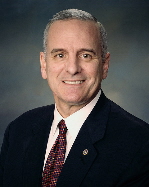Face Time: DFL Gubernatorial Candidate Communication Strategies in TV Ads
Anderson Kelliher delivers more face time in ads than other candidates; Dayton utilizes more voice-over artists and does not deliver a single message speaking directly into the camera
This is the first in a series of Smart Politics reports on campaign advertising in the 2010 Minnesota gubernatorial election.

A Smart Politics content analysis of six ads run by former State Representative Matt Entenza, five ads by former U.S. Senator Mark Dayton, and two ads by House Speaker and DFL-endorsed Margaret Anderson Kelliher finds that Anderson Kelliher has personally narrated a larger percentage of her ads than her rivals as well as delivered the largest percentage of on-camera face time.
In her two 30 second ads to date, the DFL endorsee delivers her campaign messages in her own voice for a total of 47 seconds, or 78.3 percent of the ads.
By contrast, Entenza voices 90 seconds of the three minutes in his six ads (50.0 percent), while Dayton speaks for just 37 seconds of the three minutes in his five ads (20.6 percent).
For example, in her debut ad “Minnesota Story,” Anderson Kelliher narrates over the entire 30 second spot – giving a brief account of her family’s back story in the Gopher State.
In her second ad, “Serve,” she voices 17 seconds as bookends of the 30 second spot which utilizes actors in between in a comedic attack on Governor Tim Pawlenty’s alleged political ambitions and his administration’s history of serving corporate special interests.

In the former Representative’s first two ads (“Vision” and “Me”) Entenza narrates each of the 30 second spots in their entirety.
In two of his most recent ads (“New Direction” and “Clean Up”) the narration on education and energy policy is conducted entirely by a voice-over artist.
In his two other ads (“Plan” and “Disappearing”) Entenza personally voices 16 and 14 seconds of the two 30 second spots respectively, alternating commentary with his running mate Robyne Robinson in the former and a voice-over artist in the latter.
Perhaps because he is the most well-known DFLer in next month’s primary, with a surname that has a long history in the Gopher State, Mark Dayton does not personally narrate a single frame in three of his five campaign ads: “9,000 miles” (a 60-second personal narrative), “Forged” (on education), and “So Much” (on seniors).
In his two other spots (“Fair Share” and “A Government as Good as Our People”), Dayton speaks for 18 and 19 seconds respectively on tax increases for the wealthiest of Minnesotans.
However, even when candidates narrated their own ads there was a distinct difference in how they spoke to their audience.
Smart Politics examined how much screen time each DFLer devoted to speaking on-camera, looking Minnesotans in the eye whilst delivering their campaign messages.
Margaret Anderson Kelliher utilized more than a quarter of her time in the ads speaking directly to Minnesotans, with Entenza doing so for just a shade over one-seventh of his spots, and Dayton not spending a single second looking and speaking directly into the camera.
For the 16 seconds the House Speaker appears talking on-screen in her ads, every moment is spent delivering her lines while looking directly into the camera, talking about how to “put Minnesota back to work” (“Minnesota Story”) and how she took on Governor Pawlenty to “fix our bridges and stop cuts to health care and schools” (“Serve”).
Entenza spends 27 seconds of his three minutes of television advertising speaking directly to the viewers (15.0 percent). In his first two ads, the former Representative introduces himself by name and talks for 16 seconds collectively about the need to “make Minnesota great again” (in “Vision” and “Me”).
In his ad on education (“Plan”) Entenza (with his running mate Robyne Robinson) speaks directly into the camera for 11 seconds about how his achievements came from Minnesota teachers who pushed him and concludes with a variation of his campaign tagline, “Making Minnesota great again starts right here.”

The only ads in which Dayton speaks on camera at all revolve around his promise to “close tax loopholes” and “make the rich pay their fair share of taxes” to raise revenue to help pay for programs like education.
However, those statements are presented with the former Senator looking away from the camera lens in on-screen ‘discussions’ with ordinary Minnesotans – around a table with townsfolk (“Fair Share”) and out in the countryside (“A Government as Good as Our People”).
Dayton never looks directly into the camera to tell voters he will raise taxes on a segment of the population.
Perhaps because Entenza and Anderson Kelliher are not quite the fixtures in Minnesota politics as Dayton, they feel a greater need to introduce themselves to voters by incorporating more of themselves into their ads than does Dayton.
A follow-up report on the content of DFL campaign advertising will be posted later this week.
Follow Smart Politics on Twitter.
